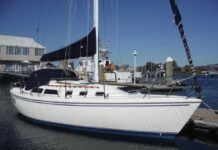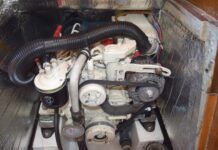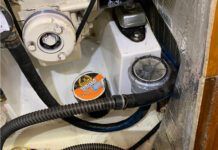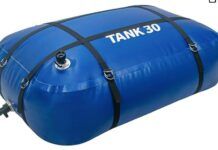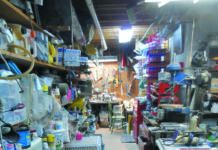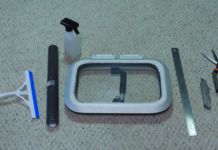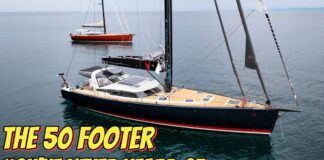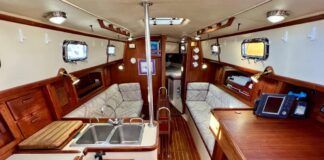Tillerpilots and cockpit wheel pilots are the low-cost alternatives to belowdeck pilots that attach directly to the rudderstock and often employ hyraulic rams to provide turning power.

Abovedeck pilots, on the other hand, use small, energy-efficient high-speed, low-torque electrical motors. They are comparatively inexpensive but not as robust.
Between the two, the tillerpilot has several distinct advantages over the wheelpilot: no belt to slip and much faster hard-over times. For these reasons, a good tillerpilot will probably do a better job steering your boat in sketchy conditions than a wheelpilot.
But what if your boat has wheel steering? Well, you might be able to rig the emergency tiller (and when was the last time you tried that?!) for attachment of a tillerpilot. When self-steering isn’t needed, simply remove the tiller and the pilot and stow.
Some cruisers have made good use of tillerpilots by attaching them to the trim tabs offered on some wind vane self-steerers, or the emergency rudder made by Scanmar to supplement its Monitor vane.
If buying a new boat, you might reconsider the tiller vs. wheel question in light of the tillerpilot’s superiority. Remember, however, that a boat that’s easy for you to steer will also be easier for the autopilot. The converse, of course, also is true.
Two Major Players
We pitted Autohelm’s and Navico’s tiller autopilots against each other in September 1996, and updated the field in October 1997 with a short review of Autohelm’s ST-1000 Plus unit. Today the two players on the field are essentially the same, although monikers have changed: The Autohelm pilots are now referred to by the parent company’s name—Raytheon. Navico, meanwhile, has been absorbed by Simrad, maker of Robertson below-deck autopilots, which sells the Navico pilots under its own name. Each company sells three models of varying power, to cover as wide as possible a range of vessel displacements..
For this test we focused on pulling power and current draw. We tested four of the six available models: Simrad’s TP10 and TP30, and Raytheon’s ST2000 Plus and ST4000 Plus. We left out the Raytheon 1000 Plus (because it’s the sole contender in the lightweight class, and was previously reviewed), and the Simrad TP20, which uses a screw-thread drive slightly more powerful than the TP10, and adds an instrument interface.
The apple among oranges was the ST4000, which is operated by a separately mounted display and whose fluxgate compass must be located away from the drive unit. The ST4000 is designed to accept and process more sources of data than the other units; it’s targeted more toward ocean passage-makers than the normal cruiser-racer. Even so, we were testing drive units, not peripheral functions, so we included it.
Gone, to the best of our knowledge, are the Tillermaster and a model once made by Plastimo
Testing Procedure
As nice as it would have been to take all these tillerpilots out on the water, it wasn’t necessary for these tests. Instead, we hinged a tiller to an upright and put a bench underneath it. At one end of the bench we clamped a stack of wood with a hole drilled for the bearing cups that accept the pins at the outboard ends of the pilots; at the other end we rigged a gantry with a hanging block through which we could swing 20-lb. and 44-lb. weights to oppose the pilots (see table notes), while measuring hard-over times.
Click here to view Value Guide: Tillerpilots.
We tied the line from the block to the tiller about 2″ forward of the pin. This set-up allowed us to exchange units quickly, and to make adjustments to assure that we had level conditions and straight pulls from the block to the actuator rods. It also let us set the tiller amidships at the mid-point of each actuator stroke, although the stroke lengths were so similar in all units that we actually had to move the butt-end arrangement very little.
All the manuals were clear about how these units should be mounted in real boats. The watchwords are “straight” and “level.” Understanding the variety of cockpit and tiller arrangements possible, as well as owner preferences, engineers for both companies provide plenty of mounting options and accessories to cover the gamut. In our tests the distances to the fuse panel, and thence to the battery, were short. We used 14-gauge wire throughout. We made repeated tests in series in order to account for the inaccuracies inherent in eyeballing the multimeter readings and in working a stopwatch with one hand while holding down the directional buttons on the tillerpilots with the other. We recorded the results of each series of tests separately, without reference to the performance of the other units tested.
Simrad TP10
This is a stand-alone tillerpilot—no interface with other instruments. It has an internal fluxgate compass that, like the others in the test, is calibrated by turning the boat in a slow circle. It was easy to set up—two wires for the power circuit, end of story. The mechanism is a drivescrew, also known as a screw-thread, that pushes and pulls the piston attached to the tiller. This was the only screw-driven pilot in the bunch, and although it was slower than the others it had a reassuringly solid and uniform sound under pressure compared to the recirculating ball drives, which seemed to clatter a bit.

The TP10, like its beefier sibling the TP30, is controlled by five buttons on the keypad—one for calibration, one for toggling between Standby and Auto (a push of this one locks the boat onto the current course); two for course changes to port or starboard (one push gives a 1° change, a hold-down gives changes in 10° increments); and one for auto-tacking. The last is pushed in conjunction with a directional button, and steers the boat through a 100° course change in the desired direction. The pilot will automatically assess and compensate for weather helm and course variations due to sea state, although both settings can be changed manually.
In our tests, the TP10 was slower than advertised in the no-load and 44-lb. load hard-over times. It was also greedy in electrical consumption compared to all three other pilots in all tests except one—the Raytheon ST4000 drew more power for the 20-lb. pull.
The TP10 was the first of the units to arrive for the test. We used it to set up the bench configuration and got attached to it—it was simple and impressive under load…until the recirculating ball units showed up and went faster with less effort. To make sure, we retested the TP10 two more times, but the numbers didn’t improve.
Raytheon ST2000 Plus
Raytheon’s packaged drive unit, very similar in size and weight to both Simrad units, was more than twice as fast as the TP10 in both weight tests, while drawing less current. It’s also rated at 26 pounds more maximum thrust. Interestingly, Raytheon recommends the ST2000 for boats up to 10,000 lbs., whereas Simrad says the TP10 is good up to 11,000 lbs.
The performance difference can be chalked up to the drive mechanisms—recirculating ball versus drivescrew. This is borne out by the fact that Simrad’s TP30, a recirculating ball unit, performed almost identically to the ST2000.
The controls on the ST2000 are a bit different from those on the Simrads. The Raytheon unit has a six-button keypad: The Auto button locks the boat on the current course; the separate Standby button allows a return to hand steering. When the pilot is engaged, course changes are made by pushing dedicated 1° or 10° buttons. The ST2000 tacks automatically through 100° to starboard if the +1 and +10 buttons are pushed simultaneously, and to port if the –1 and –10 buttons are pushed.
Calibration features are accessed by holding the Standby button for 5 seconds, then toggling to different functions with the Auto key and making adjustments with the +1 and –1 keys.
Like the Simrad units, the ST2000 can automatically minimize rudder movement once it processes a series of normal on-course variations, as well as compensate for yawing in a heavy or confused sea. These features, too, can be set manually.
The ST2000 has a display window to provide clues about the unit’s current functions. The basic display is simply compass heading, but when interfaced with other instruments—through Raytheon’s proprietary SeaTalk protocol or NMEA 0183 ports—the window will show readings for range and bearing to waypoint, cross-track error, and so on.
Simrad TP30
The TP30 dimensions and keypad operations are identical to the TP10, except that the TP30 adds interface functions for communicating with the Navico Corus instrument system, Simrad’s IS15 instruments, or with other manufacturers’ instruments via the NMEA 0183 protocol. A display window on the tillerpilot body would come in handy here, as a simple function reference for the helmsman.
The main difference in drive performance is the mechanism; in the TP30 it’s a recirculating ball drive, which gives the unit 44 more pounds of peak thrust than the TP10, and more than doubles the speed of the piston. Simrad’s engineers say that the recirculating ball drive produces less drag and less friction, thus increasing speed and saving power. Asked if the drivescrew mechanism is more or less hardy than the recirculating ball drive, they say that service records don’t indicate a superiority either way; the longevity of a pilot, no matter what its drive mechanism, is a function of how long and hard it has worked, and whether it’s been maintained.
In the 20-lb. and 44-lb. pulls, the TP30 took exactly the same amount of time to move from lock to lock as Raytheon’s ST2000. The operating stroke on both units is listed as 10″; we measured the pin movement on the TP30 at 10″, but the ST2000 came up a bit short at 9.38″. All else being equal, the TP30’s extra throw translates into greater rudder movement.
The TP30 drew a bit more current than the other units in standby mode, but was significantly more modest in its electrical demands under load than all three of its competitors.
Raytheon ST4000 Plus
The ST4000 is offered as a “no-compromise” unit for sailors who push their boats hard on long ocean passages. It’s not a one-piece unit, as are the other three in our tests; the ST4000 package consists of a tiller-drive unit, a separate fluxgate compass, and a separate display/control unit, which also acts as a repeater for other instruments connected through Raytheon’s SeaTalk or NMEA 0183 protocols. The drive is claimed to handle displacement loads up to 14,300 lbs. in its standard configuration, and 20,000 lbs. with an optional stronger drive unit. The reported peak thrust of the ST4000 is 185 lbs., very close to the number claimed by Simrad for the TP30.
In our tests, the ST4000 drew the least power in standby mode, but didn’t distinguish itself in the pulling tests either in speed or current conservation, at least compared with the ST2000 and the TP30. This apparent deficiency may be addressed by “AutoDockside” software included with the unit. The software, according to Raytheon, helps the ST4000 calibrate itself accurately and improves drive control in the long run. We weren’t able to observe any such effect with our brute force tests, but long-term power efficiency may be grist for another set of observations in the future.
Conclusions
If what you need is a simple helping hand and don’t care about connecting to other instruments—or about a particularly rapid response on the helm—then Simrad’s TP10 would make a good, sturdy choice. The price is right. For another $200 you could add interface capabilities and a bit more power with the TP20, but at that point we think it would be wise to spring for a recirculating ball drive, either the Raytheon ST2000 or the Simrad TP30. Between those two the choice is difficult. The street price of the TP30 is currently a bit higher than that of the ST2000. The five-button control area on the TP30 is arguably simpler, although these are always matters of personal preference. Meanwhile the ST2000 offers a valuable information display. Both units are well-engineered, both come with full interface capability, both are typically offered with handheld remote controls…
In our weighted pulling-power tests the two units were identical, with the TP30 having a slight edge in current consumption and operating piston length. According to the strict test parameters, then, the Simrad TP30 gets the blue ribbon by a nose: It pulled a twitch farther in the same time, with less effort. It could, as noted earlier, benefit from a display.
Contacts– Simrad, 19210 33rd Ave. West, Suite A, Lynnwood, WA 98036; 425/778-8821. Raytheon Marine Co. (Autohelm), 22 Cotton Road, Unit H, Nashua, New Hampshire 03063; 603/881 5200.




